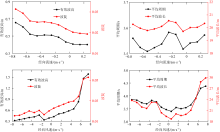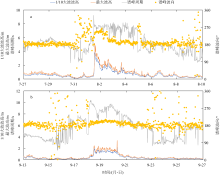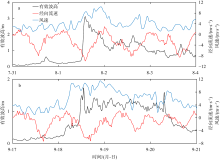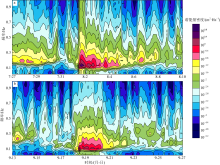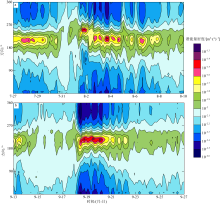Journal of Tropical Oceanography ›› 2023, Vol. 42 ›› Issue (4): 25-35.doi: 10.11978/2022157CSTR: 32234.14.2022157
• Marine Hydrology • Previous Articles Next Articles
Observation characteristics of coastal waves in Sanya and their responses to typhoon processes
LI Junmin1,2,3( ), LI Bo1,3, CHEN Wuyang1, LIU Junliang1,3(
), LI Bo1,3, CHEN Wuyang1, LIU Junliang1,3( )
)
- 1. State Key Laboratory of Tropical Oceanography, Key Laboratory of Science and Technology on Operational Oceanography, South China Sea Institute of Oceanology, Chinese Academy of Sciences, Guangzhou 510301, China
2. Sanya Institute of Ocean Eco-Environmental Engineering, Sanya 572000, China
3. Southern Marine Science and Engineering Guangdong Laboratory (Guangzhou), Guangzhou 511458, China
-
Received:2022-07-13Revised:2022-08-31Online:2023-07-10Published:2022-09-01 -
Supported by:Hainan Provincial Natural Science Foundation of China(422MS160); Science and Technology Planning Project of Guangdong Province of China(2021B1212050023); National Natural Science Foundation of China(42130404); Key Research Program of Frontier Sciences, Chinese Academy of Sciences(QYZDJ-SSW-DQC034)
Cite this article
LI Junmin, LI Bo, CHEN Wuyang, LIU Junliang. Observation characteristics of coastal waves in Sanya and their responses to typhoon processes[J].Journal of Tropical Oceanography, 2023, 42(4): 25-35.
share this article
Add to citation manager EndNote|Reference Manager|ProCite|BibTeX|RefWorks
| [1] |
范顺庭, 王以谋, 1999. 黄河口海域特征波浪要素比的分析[J]. 海洋预报, 16(1): 22-28.
|
|
|
|
| [2] |
冯兴如, 李近元, 尹宝树, 等, 2018. 海南东方近岸海域海浪观测特征研究[J]. 热带海洋学报, 37(3): 1-8.
doi: 10.11978/2017102 |
|
doi: 10.11978/2017102 |
|
| [3] |
葛明达, 1984. 连云港波高波周期统计分布[J]. 海洋工程, (1): 40-50.
|
|
|
|
| [4] |
黄心裕, 唐军, 王晓宇, 2022. 基于Prophet算法的海南近海波浪长时段时序分析与预测[J]. 海洋学报, 44(4): 114-121.
|
|
|
|
| [5] |
李淑江, 李泽文, 范斌, 等, 2016. 海南岛东南近岸海浪观测及统计特征[J]. 海洋科学进展, 34(1): 1-9.
|
|
|
|
| [6] |
孙璐, 黄楚光, 蔡伟叙, 等, 2014. 广海湾海浪要素的基本特征及典型台风过程的波浪分析[J]. 热带海洋学报, 33(3): 17-23.
|
|
doi: 10.11978/j.issn.1009-5470.2014.03.003 |
|
| [7] |
严珍珍, 杜小平, 范湘涛, 2019. 三亚湾海岸动力演变的数值模拟研究[J]. 海岸工程, 38(3): 176-186.
|
|
|
|
| [8] |
姚顺, 马宁, 丁俊杰, 等, 2021. 规则波与流相互作用的数值模拟与不确定度分析[J]. 哈尔滨工程大学学报, 42(2): 172-178.
|
|
|
|
| [9] |
张存智, 张健民, 窦振兴, 等, 1995. 三亚电厂码头航道泥沙洄淤预测[J]. 海洋环境科学, 14(4): 1-8.
|
|
|
|
| [10] |
doi: 10.3390/jmse10050706 |
| [11] |
|
| [12] |
doi: 10.1016/j.ecss.2019.106551 |
| [13] |
|
| [14] |
doi: 10.1016/j.egyr.2022.03.177 |
| [15] |
doi: 10.2112/SI99-019.1 |
| [16] |
|
| [17] |
doi: 10.1029/2017JC013555 |
| [18] |
doi: 10.1016/j.coastaleng.2019.02.006 |
| [19] |
doi: 10.1007/s13131-017-1073-4 |
| [1] | SUN Zeming, HAN Shuzong, WANG Mingjie, SU Hanxiang. Statistical study on the influence of typhoon with different path on the temperature of coastal waters of China [J]. Journal of Tropical Oceanography, 2024, 43(5): 17-31. |
| [2] | YUAN Yu, XU Haiming, MA Jing, ZHANG Tong. Impact of Atlantic Multidecadal Oscillation on interannual relationship between ENSO and early summer marine heatwaves in the Western Pacific* [J]. Journal of Tropical Oceanography, 2024, 43(5): 1-16. |
| [3] | SHANG Jie, WU Ying, ZOU Yike, MA Jingwen. Retrieval of typhoon precipitation rate over ocean surface based on FY-3D/MWRI Data* [J]. Journal of Tropical Oceanography, 2024, 43(5): 32-40. |
| [4] | ZHANG Zheran, HU Junyang, ZHOU Kai, ZHANG Penghui, XING Jiuxing, CHEN Shengli. Storm surge simulations of the coastal area of Shenzhen using different types of typhoon meteorological fields—a case study of Typhoon Mangkhut* [J]. Journal of Tropical Oceanography, 2023, 42(6): 1-14. |
| [5] | CHU Xiaoqing, PENG Qihua. The role of alongshore wind and ocean wave in generating the northward Somali Current [J]. Journal of Tropical Oceanography, 2023, 42(2): 1-8. |
| [6] | GAO Na, ZHAO Mingli, MA Yi, XU Wanming, ZHAN Haigang, CAI Shuqun. Effect of typhoon on storm surge in the Pearl River Estuary [J]. Journal of Tropical Oceanography, 2023, 42(1): 32-42. |
| [7] | LI Yanjie, ZHU Yousheng, CHEN Guanjun, WANG Shu, WANG Weiwei. Analysis of shallow surface fine geological characteristics and hazard factors of the seabed in the northern part of Dongsha, South China Sea based on AUV data [J]. Journal of Tropical Oceanography, 2023, 42(1): 114-123. |
| [8] | XIE Jieshuo, GONG Yankun, NIU Jianwei, HE Yinghui, CHEN Zhiwu, XU Jiexin, CAI Shuqu. Spatial-temporal variations of the dynamic parameters of internal solitary waves in the Sulu-Celebes Sea [J]. Journal of Tropical Oceanography, 2022, 41(6): 132-142. |
| [9] | TANG Ling, NIE Yuhua, WANG Ping, TANG Chaolian. Trend analysis of marine heatwaves variability in the outer Pearl River estuary from 1974 to 2020 [J]. Journal of Tropical Oceanography, 2022, 41(6): 143-150. |
| [10] | SHU Aiqing, XU Dongmei, LI Hong, WU Haiying, SHEN Feifei, DEND Hua, BAI Yawen. Assimilating MWHS-2 radiance of FY-3D satellite and its influence on the forecast of Typhoon Mitag* [J]. Journal of Tropical Oceanography, 2022, 41(5): 17-28. |
| [11] | GUO Junli, SHI Lianqiang, CHEN Shenliang, ZHANG Min, CHANG Yang, ZHANG Daheng. Dynamic variations of different sedimentary geomorphology of sandy and gravel embayed beaches on the Zhujiajian Island during typhoon season [J]. Journal of Tropical Oceanography, 2022, 41(4): 82-96. |
| [12] | XI Yangyang, WANG Riming, FENG Bingbin, CHEN Bo. Morphodynamic processes of the Yintan Beach in response to typhoon [J]. Journal of Tropical Oceanography, 2022, 41(4): 97-104. |
| [13] | ZENG Yigang, JING Zhiyou, HUANG Xiaolong, ZHENG Ruixi. Analysis of the dynamic characteristics of the east Guangdong shelf front in the northern South China Sea in summer [J]. Journal of Tropical Oceanography, 2022, 41(4): 136-145. |
| [14] | LI Zhuo, LI Weibiao, ZHANG Aoqi. Analysis of diurnal variation characteristics of precipitation over South China before typhoon landfall [J]. Journal of Tropical Oceanography, 2022, 41(2): 26-37. |
| [15] | WANG Lifang, HUANG Tao, DU Chuanjun, GUO Xianghui. Comparison of different continuous in-situ observation systems in seawater [J]. Journal of Tropical Oceanography, 2021, 40(3): 103-113. |
|
||




















